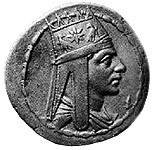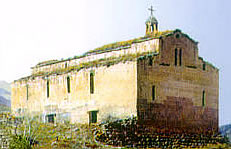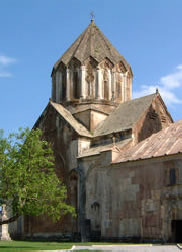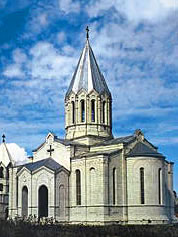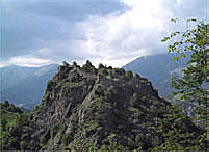 |
 |
| |



A Brief History of the Art and Architecture
of Artsakh — Nagorno Karabakh
An exclusive overview for www.nkrusa.org
Introduction
The art created in Armenia's historical province of Artsakh, the largest part of which is known today as Nagorno Karabakh, constitutes one of the important chapters in the history of Armenian art. It has progressed through the same major stages as did Armenian art in a larger sense: from pre-Christian times to the adoption of Christianity early in the fourth century, through the Middle Ages, and from there — to the era of modernity. As in many other Christian cultures, the principal expression of Artsakh's art in the Middle Ages was through ecclesiastical architecture: churches, cathedrals, chapels and monasteries. Most other forms of art in that period, including illuminated manuscripts, khachkars (unique-to-Armenia stone slabs with engraved crosses) and mural paintings were likewise tied to Artsakh's religious life and its primary institution — the Armenian Apostolic Church.
Artsakh has been rightfully called an open-sky treasure-house of various forms of Armenian architecture. Overall, Artsakh, including adjacent areas that lay outside of the boundaries of today's Nagorno Karabakh Republic, contains up to 1700 architectural artifacts. In addition to ecclesiastical structures, this number includes samples of civil architecture, ancient castles and fortresses as well as numerous khachkars.
Pre-Christian Era
The earliest monuments in Artsakh relate to the pre-Christian era when polytheism was the most widespread form of religion. The most curious art form from that time period is, perhaps, large anthropomorphic stone idols that are found in the eastern lowlands of the northern counties of Jraberd and Khachen. They date from the Iron Age. Also, in the northeastern outskirts of the Nagorno Karabakh Republic, and further to the east, so-called sahmanakars ("Border Stones") are found. They originally appeared during the reign of the Artashessian (Artaxiad) royal dynasty in Armenia (190 BC-53 AD) who used the stones, with inscriptions, to demarcate the kingdom's frontiers for travelers. In Artsakh, the tradition of marking borders with sahmanakars endured throughout the Middle Ages. The largest of such medieval markers stands near the town of Mataghes in the Mardakert District. An inscription on the stone declares: "Here [the province of] Siunik ends."
|
|
The most famous representative of the Artashessian dynasty was Tigran II the Great (95 BC-55 BC), under whom the Kingdom of Armenia stretched from the Caspian Sea to the Mediterranean Sea. Recognizing the important position of Artsakh inside his kingdom, Tigran II built a city in the region and named it Tigranakert after himself (Tigranocerta, in Roman sources); its ruins are found some 50 miles to the northeast of the Nagorno Karabakh Republic's present-day capital of Stepanakert. Between Tigranakert and Stepanakert, and elsewhere in Artsakh's lowlands, it was common to find well-preserved silver currency minted by the Artashessians. One side of these coins feature profiles of the kings who are depicted in traditional Armenian royal tiaras embellished with the symbol of the House of the Artashessians — an eight-beam star guarded by two eagles.
Ecclesiastical Architecture
Works of architecture in Artsakh are constructed according to similar principles and with the use of the same techniques as those in the rest of Armenia. Volcanic rock and limestone are the principal building materials that form the nucleus for the walls. They are then covered with facing. In large buildings in cities or in monasteries the exterior facing can consist of carefully cut blocks. The monasteries of Gandzasar and Dadivank serve as the primary examples of that style. For more modest structures, such as parish churches in provinces, it was common to use less carefully cut stone, a practice which creates a more rustic appearance.
In most cases, facades and walls of Artsakh's churches and monasteries contain embedded khachkars as well as engraved texts in Armenian that often provide the precise date of construction, names of patrons and, sometimes, even the name of the architect. Covering the walls of churches and monasteries with ornamented texts in Armenian developed in Artsakh, and in many other places in Armenia, into a unique form of decor. Compared with other provinces of the historical Armenia, the land of Artsakh contains the largest number of Armenian lapidary (inscribed in stone) texts per unit of territory, which date from the fifth century.
The Early Middle Ages
In the early Middle Ages, Artsakh and neighboring provinces, known together as The Eastern Prefectures of Armenia (Koghmank Arevelitz Haiotz), became a target of missionary activities of prominent religious leaders from Armenian mainland. The most distinguished of them were St. Gregory the Illuminator (died circa 337 AD), who baptized Armenia into the first Christian state in 301 AD, and St. Mesrob Mashtotz (361-441 AD), the scholar who created the Armenian alphabet.
|
|
A number of Christian monuments that are identified with that vital period of the Armenian history belong to the world's oldest places of Christian worship. Among them is the Amaras Monastery, which, according to ancient authors, was founded in the 4th century AD by St. Gregory himself. The oldest part of the monastery is the martyrium of St. Grigoris, St. Gregory's grandson and Bishop of Aghvank, who was killed by the pagans, in 338 AD, when teaching Gospel in the land of the Mazkuts (present-day Republic of Dagestan, in Russia). The mausoleum of St. Grigoris is a vaulted burial chamber equipped with two lateral vestibules that serves as the crypt for a church dating from a later period. While traveling in Artsakh and the neighboring provinces of Siunik and Utik, in circa 410 AD, St. Mesrob Mashtotz established a school at Amaras where the Armenian script, invented by him in 405 AD, was first introduced for teaching purposes. The description of St. Mesrob Mashtotz's journey to Artsakh and the neighboring province of Utik features prominently in the "History of Aghvank," written in the 7th century by one of Artsakh's most prominent natives — Armenian historian Movses Kaghankatvatzi.
Another temple whose history relates to the mission of St. Mesrob Mashtotz is the Targmanchatz Monastery near Karhat (present-day Dashkesan in Azerbaijan, to the north of the Nagorno Karabakh Republic). The word Targmanchatz, meaning "Saint Translators," designates both St. Mesrob Mashtotz and St. Sahak Partev, head of the Armenian Church (387-436 AD). Using Mashtotz's alphabet, St. Sahak translated the Bible from Syriac into Armenian in 411 AD. The main church of the monastery, reconstructed in 989, consists of one vaulted room (single nave) with an apse on the east flanked by two small rooms.
The basilica of St. Gevorg (St. George) at the Tzitzernavank Monastery in Kashatagh, is not only an important religious site, but is the best-preserved example of an Armenian basilica with three naves. It is a large and well-preserved structure dating probably from the fifth or sixth centuries. It stands not far from the so-called Lachin Corridor, a territory that connects Armenia with the Nagorno Karabakh Republic. The word Tzitzernavank originates from the root "tzitzern," meaning "little finger" in old Armenian. This points to a period in the history of the monastery when it was believed to contain relics of St. George the Dragon-Slayer. In the past, the monastery belonged to the Tatev eparchy and is mentioned as a notable religious center by the 13th century historian Stephanos Orbelian and Bishop Tovma Vanandetzi (1655). Beginning from 1992, when Kashatagh (Lachin) was freed from Azerbaijani occupation by the victorious army of Nagorno Karabakh Armenians, the Tzitzernavank Monastery underwent renovation and became a venue of autumn festivals organized annually on St. George's Day.
Churches with a cupola built on a radiating or cruciform floor plan were numerous in Armenia during the seventh century, and are well represented in Artsakh. One example is the chapel at Vankasar where the cupola and its drum rest on the central square of a cruciform floor plan. The chapel is located on the eastern frontier of the Nagorno Karabakh Republic, and was reputedly founded by Artsakh's monarch Vachagan II the Pious of the early medieval Arranshahik dynasty. Another example is the Okhta Trne church at Mokhrenes ("The Eight-Door Church"), probably dating from the fifth to seventh centuries. Its walls, roughly cut and bonded, enclose a quatrefoil interior with four small diagonal niches. Less common is the free cross plan with a cupola, found in the Chapel of St. Savior in the Mardakert District.
Artsakh's designs at times veered from the course of the architectural evolution of mainland Armenia. Observations suggest that certain floor plans frequently employed in other regions of Armenia during the seventh century are not found in Artsakh. These include the chamber with a cupola supported by wall braces (e.g. the cathedral in Aruj, in the Aragatzotn Province of Armenia); the cruciform plan with a cupola on four free-standing pillars (e.g. St. Gayaneh Church in the Holy City of Echmiadzin, Armenia), and the radiating type with four rooms in a rectangle (e.g. St. Hripsimeh Church in the Holy City of Echmiadzin, Armenia).
The Golden Age of Artsakh's Art and Architecture
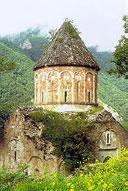 Memorial Cathedral, Dadivank Monastery (1214-1237) |
Another peculiarity of the region is that few of Artsakh's monuments date from the post-Arab period or the rise of Armenian kingdoms (ninth to the eleventh centuries), which was a very productive artistic era in other Armenian provinces. The structures that could be attributed to that period are chapels on the cruciform plan with a cupola, such as the church at Varazgom near Kashatagh, the Khunisavank Monastery in Getabaks (Kedabek district of Azerbaijan, north to the Nagorno Karabakh Republic), and churches with a single nave, such as the church at Parissos in Getabaks.
It was during the post-Seljuk period and the beginning of the Mongol period (late twelfth and thirteenth centuries) when Artsakh's architecture blossomed. Monasteries in this era served as active centers of art and scholarship. Most of them contained scriptoria where manuscripts were copied and illuminated. They also were fortified and often served as places of refuge for the population in times of trouble.
Several monastic churches from this period adopted the model used most widely throughout Armenia: a cathedral with a cupola in the inscribed cross plan with two or four angular chambers. Examples include the largest and most complex monasteries of Artsakh: Dadivank (1214-1237), Gandzasar (1216-1238) and Gtichavank (1241-1246). In the case of the Gandzasar and Gtichavank monasteries, the cone over the cupola is umbrella-shaped, a picturesque design that was originally developed by the architects of Armenia's former capital city of Ani, in the tenth century, and subsequently spread to other provinces of the country, including Artsakh.
Like all Armenian monasteries, those in Artsakh reveal great geometric rigor in the layout of buildings. In this regard, the thirteenth century's Dadivank, the largest monastic complex in Artsakh and all of Eastern Armenia, located in the northwestern corner of the Mardakert District, is a remarkable case. Dadivank was sufficiently well preserved to leave no doubt that it was one of the most complete monasteries in the entire Caucasus. With its Memorial Cathedral in the center, Dadivank has approximately twenty different structures, which are divided into four groups: ecclesiastical, residential, defensive and ancillary.
A conspicuous characteristic of Armenian monastic architecture of the thirteenth century is the gavit (also called zhamatoun). The gavits are special square halls usually attached to the western entrance of churches. They were very popular in large monastic complexes where they served as narthexes, assembly rooms and lecture halls, as well as vestibules for receiving pilgrims. Some appear as simple vaulted galleries open to the south (e.g. in the Metz Arrank monastery); others have an asymmetrical vaulted room with pillars (the Gtichavank Monastery); or feature a quadrangular room with four central pillars supporting a pyramidal dome (the Dadivank Monastery). In another type of gavit, the vault is supported by a pair of crossed arches (the Horrekavank and Bri Yeghtze monasteries).
|
|
The most famous gavit in Artsakh, though, is part of the Gandzasar Monastery. It was built in 1261 and is distinctive for its size and superior quality of workmanship. Its layout corresponds exactly to that of Haghbat and Mshkavank — two monasteries located in the northern part of today's Republic of Armenia. At the center of the ceiling, the cupola is illuminated by a central window which is adorned with the same stalactite ornaments as in Geghard and Harich (monasteries in the Republic of Armenia dating from the early thirteenth century).
The Gandzasar Monastery was the spiritual center of Khachen, the largest and most powerful principality in Artsakh, by virtue of being home to the Catholicosate of Aghvank (also known as the Holy See of Gandzasar, it was one of the territorial subdivisions of the Armenian Apostolic Church). The Gandzasar's Cathedral of St. Hovhannes Mkrtich (St. John the Baptist) is one of the most well-known Armenian architectural monuments of all times. No surprise, Gandzasar is number one tourist attraction in the Nagorno Karabakh Republic. In its decor there are elements which relate it to three other monuments, in Armenia, from the early thirteenth century: the colonnade on the drum resembles that of Harich (built around 1201), and the great cross with a sculpture of Crucifixion at the top of the facade is also found at Kecharis (built around 1214) and Hovhannavank (1216-1250).
Gandzasar and Dadivank are also well-known for their bas-reliefs that embellish their domes and walls. After the Cathedral of St. Cross on the Lake Van (now in Turkey), Gandzasar contains the largest amount of sculpted decor compared to other architectural ensembles of Armenia. The most famous of Gandzasar's sculptures are Adam and Eve, Jesus Christ, the Lion (a symbol of the Vakhtangian princes who built both Gandzasar and Dadivank), and the Churchwardens — each holding on his hands a miniature copy of the cathedral. In Dadivank, the most important bas-relief depicts the patrons of the monastery, whose stone images closely resemble those carved on the walls of the Haghbat, Kecharis and Harich monasteries, in the Republic of Armenia.
Although in this period the focus in Artsakh shifted to more complex structures, churches with a single nave continued to be built in large numbers. One example is the monastery of Yeghishe Arakyal (also known as the Jrvshtik Monastery), in the historical county of Jraberd, that has eight single-naved chapels aligned from north to south. One of these chapels is a site of high importance for the Armenians, as it serves as a burial ground for Artsakh's fifth century monarch King Vachagan II Arranshahik. Also known as Vachagan the Pious for his devotion to the Christian faith and support in building a large number of churches throughout the region, King Vachagan is an epic figure whose deeds are immortalized in many of Artsakh's legends and fairytales. The most famous of those tells how Vachagan fell in love with the beautiful and clever Anahit, who then helped the young king defeat pagan invaders.
The Late Middle Ages and Modern Times
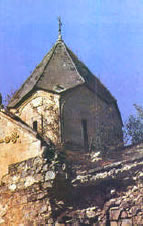 Dome of the main church, Yeritz Mankantz Monastery (1691) |
After an interruption that lasted from the fourteenth to the sixteenth centuries, architecture flourished again, in the seventeenth century. Many parish churches were built, and the monasteries, serving as bastions of spiritual, cultural and scholarly life, were restored and enlarged. The most notable of those is the Yeritz Mankantz Monastery ("Monastery of Three Infants") that was built around 1691 in the historical county of Jraberd. The monastery was established by the feudal family of Melik-Israelians, Lords of Jraberd, with an apparent purpose to rival the Holy See of Gandzasar and its hereditary patrons — the Hasan-Jalalians, Lords of Khachen.
Artsakh's architecture of the nineteenth century is distinguished by a merger of innovation and the tradition of grand national monuments of the past. One example is the Cathedral of the Holy Savior also known as Ghazanchetzotz (1868-1888). It stands in Artsakh's former capital of Shushi, and is among the largest Armenian churches ever erected. The cathedral's architectural forms were influenced by the designs of the ancient cathedral of St. Echmiadzin (4th-9th centuries), center of the Armenian Apostolic Church located to the west of Armenia's capital of Yerevan.
In addition to the Cathedral of the Holy Savior "Ghazanchetzotz," Shushi hosted the Kusanatz Anapat Monastery (1816) and three other Armenian churches: Holy Savior "Meghretzotz" (1838), St. Hovhannes "Kanach Zham" (1847) and Holy Savior "Aguletzotz" (1882).
In the nineteenth century, several Muslim monuments appear as well. They are linked to the emergence of the Karabakh Khanate, a short-lived Muslim principality in Artsakh (1760s-1805). In the city of Shushi, three nineteenth century mosques were built, which, together with two Russian Orthodox chapels, are the only non-Armenian architectural monuments found on the territories comprising today's Nagorno Karabakh Republic.
Civil Architecture
Pre-modern monuments of civil architecture and ancient fortresses are less numerous and less well preserved, as they were more exposed to the vagaries of history. However, from the seventeenth and eighteenth centuries, several palaces of Armenian meliks (dukes) should be noted, especially the Palace of the Melik-Beglarian family in Giulistan (in the Shahumian District), Palace of the Melik-Avanian family in Togh (in the Hadrut District), Palace of the Melik-Mnatzakanian family in Getashen (in the Canton of Getashen), Palace of the Melik-Haikazian family in Kashatagh (in the Kashatagh District), Palace of the Melik-Dolukhanian family in Tukhnakal (near Stepanakert) and, finally, Palace of the Khan of Karabakh in the city of Shushi. Princely palaces from earlier epochs, while badly damaged by time, are equally if not more impressive. Among those preserved is the Palace of the Dopian Princes, Lords of Tzar, near Aknaberd (in the Mardakert District).
|
|
Artsakh's medieval inns (called "idjevanatoun," in Armenian) comprise a separate category of civil structures. The best preserved example of those is found near the town of Hadrut.
Before its destruction in 1920, the main repository of the region's civil architecture was Artsakh's former capital of Shushi. In the late 19th century, Shushi became one of the largest cities in the Caucasus. In 1913, it hosted more than 42,000 people.
Shushi's architecture had its unique style and spirit. That special style synthesized designs used in building grand homes in Artsakh's rural areas (especially in the southern county of Dizak) and elements of neo-classical European architecture. The quintessential example of Shushi's residential dwellings is the house of the Avanesantz family (19th century). Shushi's administrative buildings of note include: Royal College (1875), Eparchial College (1838), Technical School (1881) summer and winter clubs of the City Hall (1896 and 1901), The Zhamharian Hospital (1900), The Khandamirian Theater (1891), The Holy Virgin Women's College (1864) and Mariam Ghukassian Nobility High School (1894). Of these buildings, only Royal College and the Zhamharian Hospital survived the Muslim attack on the city in 1920.
The Destruction of the City of Shushi by Muslim Fanatics in 1920
Events in the Southern Caucasus that followed the 1917 October revolution in Russia have had a devastating effect on the fate of the city of Shushi and on its architectural marvels. After the entry of Turko-Islamic nomads to Artsakh, in the 1750s, the city became divided into two parts: Armenian and Muslim. While the Islamic Turkic tribesmen (known since the 1920s as "Azerbaijanis") constituted less than five percent of the population of Artsakh's highlands, their largest concentration was in Shushi, where they developed difficult relations with the city's autochthonous Armenian residents. They city was a venue of sporadic inter-communal violence since 1905, but it was in March 1920 when it received the deadliest blow of all. Aided by expeditionary Ottoman forces, armed Turkic ("Azerbaijani") bands burned and destroyed all Christian quarters of the city, murdering most of its Armenian residents in the process — some 20,000 people in total.
The city's three out of five Armenian churches were totally destroyed: Holy Savior "Meghretzotz" (1838), Holy Savior "Aguletzotz" (1882) and Kusanatz Anapat (1816). The Cathedral of the Holy Savior (1868-1888) was desecrated and severely damaged. With as many as 7,000 buildings demolished, Shushi has never been restored to its former grandeur. Instead, it shrank, becoming a smaller town peopled primarily by Muslims (14 thousand residents in 1987 versus 42 thousand in 1913). It stood in ruins from 1920 up to the mid-1960s, when remnants of the city's Armenian half were bulldozed by the orders from Baku.
Castles and Forts
|
|
The fortresses of the region (called "berd" in Armenian), as in the rest of Armenia, were usually built on hard-to-reach rocks or on the tips of mountains, profitably using the features of Artsakh's rugged and heavily forested terrain. Jraberd, Handaberd, Kachaghakaberd, Shikakar, Giulistan, Mairaberd, Toghaberd, Aknaberd, Aghjkaberd and other forts, fortresses and castles belonged to Artsakh's aristocratic families, safeguarding their domains against foreign invaders that traditionally came from the eastern steppes.
The forts were established very early in the history of the region, and each successive generation of their custodians contributed to their improvement. When Artsakh's Principality of Khachen forged ties with the Kingdom of Cilicia (1080-1375), an independent Armenian state on the Mediterranean Sea that aided the Crusaders, a small number of Artsakh's fortifications acquired a certain Cilician look. The Handaberd Castle, the traditional stronghold of the Vakhtangian-Dopian Princes located in Karvachar (Azerbaijan's former district of Kelbadjar), was rebuilt with a grant received from Cilicia's King Levon; for that it was also known as "Levonaberd."
Artsakh's most remarkable pieces of the fortification art, though, are the Citadel of Shushi and Fort Mairaberd. Backed by an intricate system of camps, recruiting centers, watchtowers and fortified beacons, both belonged to the so-called Lesser Syghnakh, which was one of Artsakh's two main historical military districts responsible for defending the southern counties of Varanda and Dizak.
Khachkars
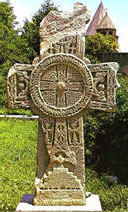 The “winged” khachkar, Arantz Monastery, 13th century |
Khachkars, stone slabs decorated with a cross, represent a special chapter in the history of sculpture, and are unique to Armenia. In the first stage of their evolution, this type of monuments already existed in Artsakh, as attested by one of the earliest dated samples found on the eastern shore of the Lake Sevan (at Metz Mazra, year 881) which at that time was part of the dominion of Artsakh's Princes of Tzar. A very large number of khachkars is also found on the territory of today's Nagorno Karabakh Republic and adjacent regions. Several thirteenth-century examples look particularly refined, and a few of them deserve a special attention for their superior design. The two khachkars of the Gtichavank Monastery, dating from about 1246 (one of which is preserved at St. Echmiadzin in Armenia), show the two bishops who founded Gtichavank. There are also the two tall khachkar plaques placed inside the Memorial Bell-Tower at the Dadivank Monastery (1283), which are veritable laceworks in stone.
Artsakh's most well-known example of embedded khachkars — where khachkars standing next to each other form some kind of hooded iconostas-in-stone — is the Bri Yeghtze Monastery, in the historical country of Varanda (presently, in the Martuni District of the Nagorno Karabakh Republic). The use of embedded khachkars in Bri Yeghtze is the same as in the Tzaghatz Kar Monastery (in the Province of Vayotz Dzor, Republic of Armenia) and in the Horomos Monastery near Kars (now in Turkey).
A large khachkar, brought from Artsakh's Arantz Monastery to St. Echmiadzin, represents a rare type of the so-called "winged crosses" which resemble Celtic cross-stones from Scotland and Ireland. The largest collection of standing khachkars in Artsakh is in the area called Tzera Nahatak, near the town of Badara.
Mural Paintings
Few of Artsakh's mural paintings were preserved, but those which survived are important for the history of Armenian fresco art because of their unique compositional features and color schemes. The largest collection of Artsakh's frescos is found inside the Memorial Cathedral (1214), at the Dadivank Monastery. The Memorial Cathedral was built by the orders of Queen Arzou of Haterk. The paintings depict St. Mary, Jesus Christ and St. Nicholas, with a group of angels and worshippers. The fresco on the southern wall shows the Holy Virgin in a long robe with a red kerchief tied around her head. She is holding an oration adorned with crosses. Another fresco portrays the Christ, as he is giving the Gospel to St. Nicholas. The fresco on the northern wall represents the birth of Jesus: St. Joseph stands at St. Mary's bedside, and the three magicians kneel in adoration in front; cherubs fly in the sky above them, singing Glory in Highest Heaven. A native of Artsakh and the 12-13th century author Kirakos Gandzaketzi hints in his "History of Armenia" that as Queen Arzou and her daughters "were gifted with exceptional artistic talent," they could have also been among those who helped paint the murals. Some other murals are found in the main parish church of the town of Arajadzor in the Mardakert District.
Illuminated Manuscripts
Artsakh's more than thirty known medieval scriptoria have produced a fair number of illuminated manuscripts, especially in the thirteenth and fourteenth centuries. These scriptoria functioned in Gandzak (present-time city of Gandja in Azerbaijan), as well as at Artsakh's monasteries of Gandzasar, Khoranashat, Targmanchatz, Holy Virgin of Tzar and Yeritz Mankantz. A group of illuminated works is specific to the regions of Artsakh and Utik; in their linear and unadorned style they resemble miniatures of the Siunik and Vaspurakan schools. These compositions are simple and monumental, often with an iconography that is original and distinct from Byzantine models. Besides depicting biblical stories, several of Artsakh's manuscripts attempt to convey the images of the rulers of the region who often ordered the rewriting and illumination of the texts. The remarkable collection No. 115, preserved at the Matenadaran (Institute of Ancient Manuscripts in Yerevan, Armenia), contains a miniature portrait of Prince Vakhtang, Lord of Haterk.
Carpets and Rugs
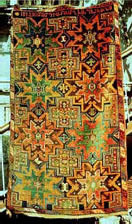 Inscribed carpet, Jraberd County (1815) |
Carpets and rugs are a form of art which is central to the artistic identity of the region. It is known that in the tenth century dyed fabrics and rugs from Artsakh were highly valued in the Arab world. Two accounts by the historian Kirakos Gandzaketzi mention embroideries and altar curtains handmade by his contemporaries Arzou and Khorishah — two princesses of the House of Upper Khachen (Haterk) — for the Dadivank Monastery. In the 19th century, local rugs and samples of natural silk production became part of international exhibitions and art fairs in Moscow, Philadelphia and Paris.
The abundance of rugs produced in the modern period is rooted in this solid ancient tradition. Indeed, recent research has begun to highlight the importance of the Armenian region of Artsakh in the history of a broader group of rugs classified as "Caucasian." Woven works by Artsakh's Armenians come in several types. Rugs in an "eaglebands " or "sunburst" pattern, a sub-type of Armenian rug featuring dragons, whose manufacturing center from the eighteenth century was Artsakh's county of Jraberd, have characteristically large radiating medallions. Other rugs come with ornaments resembling serpents ("serpentbands") or clouds ("cloudbands") with octagonal medallions comprising four pairs of serpents in an "S" shape, and rugs with a series of octagonal, cross-shaped or rhomboid medallions, often bordered by a red band. Artsakh/Nagorno Karabakh is also the source of some of the oldest rugs bearing Armenian inscriptions: the rug with three niches from the town of Banants (1602), the rug of Catholicos Nerses of Aghvank (1731), and, perhaps, the famous Guhar (Gohar) Rug (1700). It should also be added that most rugs with Armenian inscriptions come from Nagorno Karabakh.
The text is based on research
publications by P. Donabedian, Dr. L. Durnovo,
Dr. A. Yakobson, Dr. B. Ulubabian, S. Karapetian and B. Baratov.
|
|
|
734 15th Street, Suite 500, Washington, DC 20005
tel: (202) 481-3341, e-mail: info@nkrusa.org |
